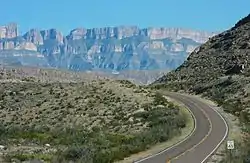Maderas del Carmen
Maderas del Carmen is a biosphere reserve in the northern Mexican state of Coahuila.
Maderas del Carmen encompasses part of the Sierra del Carmen, a northern finger of the Sierra Madre Oriental range. The reserve includes both dry Chihuahuan Desert shrublands and forested sky island, high-elevation enclaves of Sierra Madre Oriental pine-oak forest. The reserve is home to 400 bird species and 70 mammal species, including the American black bear (Ursus americanus), collared peccary (Pecari tajacu), and cougar (Puma concolor).
The region was designated a biosphere reserve in 2006. It is located in the municipalities of Ocampo, Ciudad Acuña, and Múzquiz.[1]
Conservation efforts

The isolation of the Sierra del Carmen and its relatively undisturbed environment has led to conservation efforts in Mexico and jointly with the United States. Much of the Sierra del Carmen has been declared by the government of Mexico the Maderas del Carmen Flora and Fauna Protected Area, a designation which allows many economic activities and private land holdings to continue to exist within the boundaries. The protected area comprises 520,000 acres (210,326 ha) The Maderas del Carmen is part of a bi-lateral conservation project called the El Carmen—Big Bend Conservation Corridor Initiative which includes contiguous land designated for conservation on both sides of the border totaling more than 3 million acres (1.2 million ha), an area almost as large as the U.S. state of Connecticut. In 2005, Maderas del Carmen became the first designated Wilderness area in Latin America.[2]
The Maderas del Carmen Protected Area was created in 1994, although conservation efforts were initially slowed because the land was privately owned, either in large ranches or in the collective farms called ejidos. In 2000 a Mexican corporation, Cementos de Mexico (CEMEX) began to purchase lands for conservation in the region. On CEMEX lands livestock and fences were removed and native vegetation encouraged. By 2006, CEMEX owned 195,000 acres (78,947 ha) in or near the Maderas del Carmen and managed another 62,500 acres (25,303 ha).[3]
One of the important characteristics of the Sierra del Carmen is that it functions as a "corridor" enabling wildlife to migrate north and south. In the late 1980s the corridor between the Sierra and the mountains of west Texas enabled the black bear to disperse northward and reestablish itself in Big Bend National Park. The black bear had been extirpated from west Texas in the 1950s.[4]
In other initiatives, in 2000, CEMEX in cooperation with conservation organizations in Mexico and Texas began breeding and releasing to the wild bighorn sheep which had been absent from the Sierra del Carmen for more than 50 years.[5]
On October 24, 2011, Mexico and the United States signed an agreement for "Cooperative Action for Conservation in the Big Bend-Rio Bravo Natural Area of Binational Interest."[6]
In 2020, 19 plains bisons were transported from Janos Biosphere Reserve, and formed the second herd in Mexico to reestablish wild populations of bisons.[7] The El Carmen nature reserve was established on the plains of Coahuila.[8]
References
- Government of Coahuila
- Robles Gil, Patricio "El Carmen: The First Wilderness Designation in Latin America" International Journal of Wilderness, Vol. 12, No. 2, August 2006, pp 36-40
- Gil, p.39
- "Sky island: El Sierra del Carmen" http://mexicolesstraveled.com/sierradelcarmen.htm, accessed 13 Mar 2013
- "Sky island: El Sierra del Carmen" http://mexicolesstraveled.com/sierradelcarmen.htm, accessed 13 Mar 2013
- "U.S., Mexico Announce Binational Cooperative Conservation Action Plan" News Release. U.S. Department of the Interior, 24 October 2011
- "Cemex aids reintroduction of American bison in Northern Mexico". Global Cement. 4 March 2020. Retrieved 2020-11-13.
- "Establishment of second buffalo herd celebrated in northern Mexico". Mexico News Daily. 2021-01-08. Retrieved 2021-01-09.
- Eliot, John L. (December 2002). "Borderland Comeback". National Geographic Magazine.
- "Cemex Announces its Conservation Model" (Press release). Cemex. 2001-07-27.
